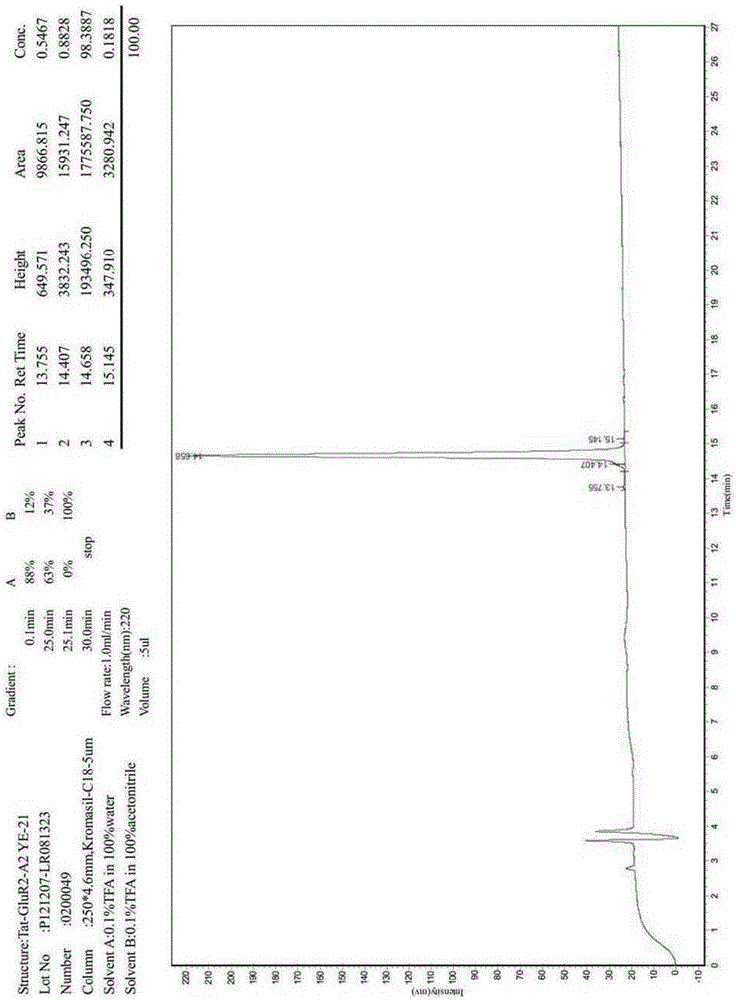Short peptide blocking long-term synaptic potentiation (LTP) and application thereof
A technology of long-term enhancement and short peptides, which is applied in the field of biomedicine to achieve high specificity, wide application prospects, and increased applicability and application range.
- Summary
- Abstract
- Description
- Claims
- Application Information
AI Technical Summary
Problems solved by technology
Method used
Image
Examples
Embodiment 1
[0029] The synthesis of embodiment 1 short peptide of the present invention
[0030] The short peptide sequence KEGYNVYGIE (KE10) or KEGYNVYGLE (KE10A) of the present invention and its control peptide KGAEVGINEA (SKE10) or modified peptides were synthesized by known and mature methods in the art, and were synthesized by GL Biochem (Shanghai) Co., Ltd. Such as figure 1 , figure 2 with image 3 As shown in the HPLC chromatogram, all synthetic short peptide products were analyzed for purity by high-pressure liquid chromatography (HPLC), and the purity was greater than 90%, which met the design requirements.
[0031] Embodiment 2 short peptide modified peptide
[0032]The invention discloses that without changing the spatial structure and stability of the short peptide, the N-terminus and the C-terminus of the short peptide are respectively modified to penetrate the cell membrane function and fluorescent labeling, so as to increase the function of the short peptide to penetrat...
Embodiment 3
[0036] Example 3 Activity of short peptides: short peptides KE10 and KE10A can block the expression of synaptic plasticity LTP, but have no effect on synaptic plasticity LTD.
[0037] (1) Experimental method
[0038] In this experiment, short peptides KEGYNVYGIE (KE10) and KEGYNVYGLE (KE10A) were selected for experiments; at the same time, a series of control experiments were performed with the control sequence short peptide KGAEVGINEA (SKE10) as a control short peptide.
[0039] Male SD rats aged 19-21 were selected, and the electrophysiological technique of isolated brain slices was used to record the synaptic plasticity in the CA1 region of the hippocampus. For the specific method, refer to the paper published by Han Huili et al. The brief description is as follows: Animals were anesthetized with ether until the muscle tension disappeared, and the rapid beheaded. After the skull is peeled off to expose the brain surface, the whole brain is taken out, trimmed into the desir...
Embodiment 4
[0048] Example 4 Activity of Short Peptide Modified Peptide: The modified peptide Tat-KE10 of short peptide KE10 can also block the expression of synaptic plasticity LTP
[0049] (1) Experimental method
[0050] In this experiment, the short peptide KEGYNVYGIE (KE10) was selected to connect with the Tat short peptide (YGRKKRRQRRR) with the ability to penetrate the cell membrane to form Tat-KE10. A short peptide, forming Tat-SKE10, was used as a control short peptide for a control experiment.
[0051] Select 18-22g male Kunming mice, and use isolated brain slice electrophysiological techniques to record synaptic plasticity in the CA1 region of the hippocampus. The preparation method of the brain slices was consistent with that of Example 3. Since the polypeptide can freely penetrate the cell membrane and enter the cell after being modified with a membrane-penetrating peptide, the administration method can be administered through circulating fluid. Under this experimental con...
PUM
| Property | Measurement | Unit |
|---|---|---|
| electrical resistance | aaaaa | aaaaa |
Abstract
Description
Claims
Application Information
 Login to View More
Login to View More - R&D
- Intellectual Property
- Life Sciences
- Materials
- Tech Scout
- Unparalleled Data Quality
- Higher Quality Content
- 60% Fewer Hallucinations
Browse by: Latest US Patents, China's latest patents, Technical Efficacy Thesaurus, Application Domain, Technology Topic, Popular Technical Reports.
© 2025 PatSnap. All rights reserved.Legal|Privacy policy|Modern Slavery Act Transparency Statement|Sitemap|About US| Contact US: help@patsnap.com



